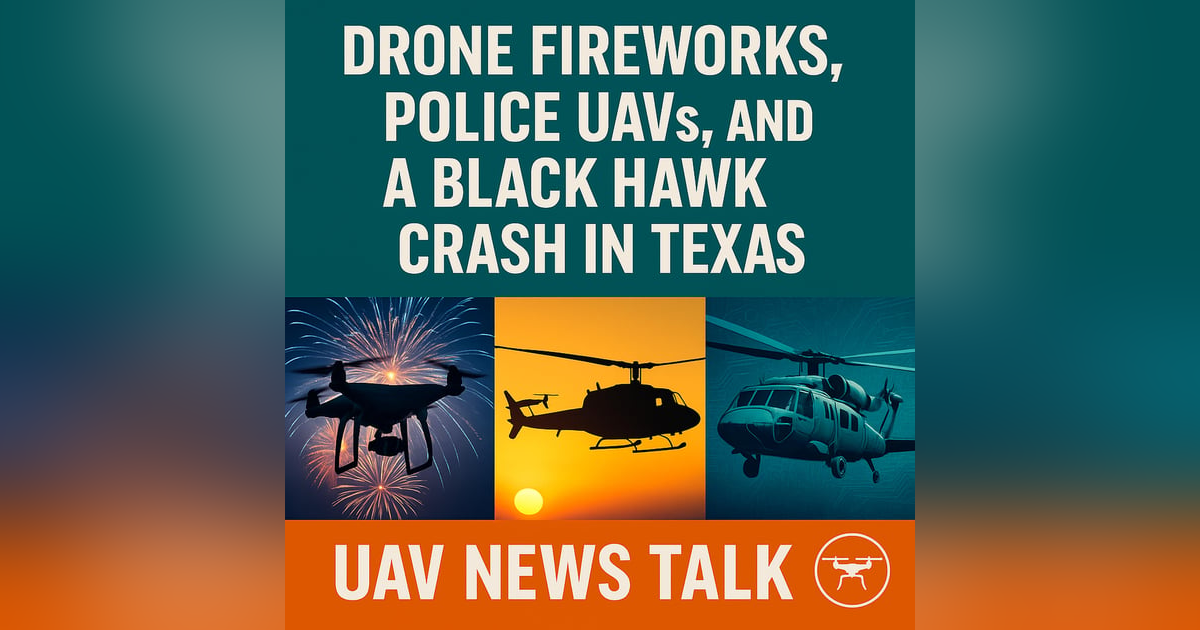Drone Fireworks, Police UAVs, and a Black Hawk Crash in Texas

In Episode 432 of UAV News Talk, Max Trescott and David Vanderhoof explore the evolving role of drones in public events, law enforcement, and emergency response—highlighting both their growing utility and the risks of poor coordination. Titled "Drone Fireworks, Police UAVs, and a Black Hawk Crash in Texas," this episode covers breaking drone news from California and Texas, trends in UAV policing, and innovations in helicopter autonomy from Sikorsky and Skyryse.
The episode opens with Max sharing a personal story about diving back into ham radio and noting the crossover with FPV drone pilots who use amateur radio frequencies for extended range. It’s a humorous but insightful segue into the broader theme: drones are becoming essential tools in unexpected places, from backyard hobbies to high-stakes public safety operations.
🎆 Drones Replace Fireworks in San Jose
The first major story is about San Jose, California, where a last-minute shift from traditional fireworks to a July 4th drone light show occurred following a major fireworks factory fire in the Central Valley. With pyrotechnics canceled, city officials quickly pivoted to a drone display. The mayor noted that the cost of drone shows is “comparable to fireworks,” depending on the number of drones used. Max and David discuss how drone shows have grown increasingly sophisticated, but viewers should be aware that real-time transitions between drone formations are slower than what’s shown in sped-up YouTube clips.
Drone light shows are not just a visual marvel—they’re also a safer and more sustainable alternative to traditional fireworks. This switch is becoming part of a national trend, particularly in fire-prone areas like California. But San Jose’s drone integration didn’t stop at entertainment.
🚨 Police Drones Monitor Illegal Fireworks
San Jose also deployed police UAVs to monitor for illegal fireworks across the city, joining another California municipality doing the same. Max shares how drone surveillance is increasingly used to spot unlawful activity on holidays like the Fourth of July. David warns hobbyists against the temptation to fly drones into fireworks displays for viral footage, noting that it’s both dangerous and illegal.
These developments tie into a larger trend: law enforcement agencies across California are embracing drones as essential tools for first response. Max and David detail programs in San Jose, Alameda County, Elk Grove, and Los Angeles, where drones are now dispatched to emergency scenes—sometimes arriving before officers 74% of the time, as was the case in Elk Grove.
Drones are being used to safely observe volatile situations like domestic disputes and fleeing suspects. In one example from San Leandro, UAVs tracked a suspect hiding under a box in a backyard, guiding officers to the location with minimal risk. Applications also include search and rescue, missing persons, and real-time crowd monitoring.
👁️ Privacy Concerns and the Future of Police UAVs
While the benefits are clear, David raises privacy concerns, such as whether UAV-collected evidence is admissible in court or if warrants are required. The discussion highlights future scenarios where drones equipped with AI and facial recognition technology could misidentify individuals, leading to false arrests.
Max compares this to helicopters used by NYPD during 9/11, which had long-range surveillance capabilities. The same tech is now migrating to drones, which are cheaper to operate and able to hover closer to the action.
🚁 Black Hawk vs. Drone: Collision in Texas Flood Zone
The most serious story in the episode comes from Kerr County, Texas, where a drone collided with a Bell 206 helicopter during a search-and-rescue mission in flood conditions. Thankfully, no one was injured, but the collision underscores the risks of deploying UAVs without coordination. The drone was reportedly operating without proper integration into the rescue efforts.
Max and David stress the importance of respecting Temporary Flight Restrictions (TFRs) and coordinating with emergency services. Unauthorized drones have repeatedly grounded firefighting aircraft during wildfires and now threaten helicopter rescue crews in flood zones. The hosts remind licensed drone pilots to fly responsibly, especially during emergencies.
🤖 Sikorsky’s AI-Powered Black Hawk: Autonomy in Rotorcraft
From disaster to innovation, the episode turns to Sikorsky’s announcement about advancing AI-driven autonomous flight for their H-60 Black Hawk helicopters. David explains how the Black Hawk is now being tested as an optionally piloted aircraft—capable of flying with or without a human pilot. This would allow military operators to use the aircraft in dangerous or high-tempo environments without risking human lives.
Max highlights how companies like Skyryse are also transforming helicopters. He shares insights from his FLYING Magazine article on Skyryse's retrofitted autonomous R66 helicopter, controlled via a single joystick with all traditional flight controls removed. Max had the opportunity to fly the simulator and compares it to a standard R66 experience.
The appeal of retrofitting existing, certified platforms like the Black Hawk or R66 is that it fast-tracks deployment. Instead of waiting years for eVTOL aircraft to be certified, these aircraft already have flight-proven designs and infrastructure.
🧩 From Kitty Hawks to Flying Cars at the Helicopter Museum
David wraps up with an inside look at the American Helicopter Museum near Philadelphia, which recently acquired two Kitty Hawk Flyers, early eVTOL prototypes meant for recreational use over water. Though commercially unsuccessful, they’re now hands-on exhibits for the public. He also previews upcoming museum displays focused on Naval and Marine Corps rotorcraft history and encourages listeners to visit helicoptermuseum.org.










